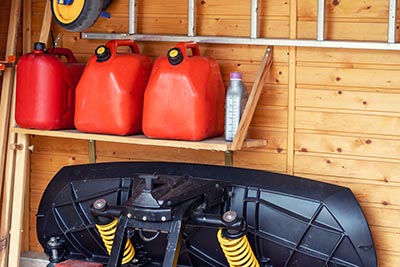
Whether you are a prepper concerned about fuel supply shortages or want to be prepared by creating an SHTF plan, storing gasoline at home is an easy way to take control of your fuel supply.
Gasoline is one of the least understood prepper resupply items. Unlike water or food, storing it is trickier.
So, to help you prepare, below are some tips to properly and safely keep gasoline on hand.
Can you stockpile gasoline?
Well, yes. You can stockpile gasoline at home, but you must use extreme caution.
If you don’t do it correctly, your fuel supply may spoil or explode. The EPA advises customers not to store more than 1 to 5 gallons for safety concerns. Meanwhile, the National Fire Protection Association recommends a maximum of 25 gallons. Local fire codes determine your stockpile’s legality: You can’t retain more than 2.5 gallons in New York City.
You won’t need 2 gallons of fuel per day to travel to work and the store after a severe SHTF event (hint: you won’t be going to work, and the supermarkets will be empty!).
What you will need a fuel supply for is the following:
- For your bug-out vehicle
- For your gas-powered tools
- For your generator
The best places for gasoline storage
If not done correctly, storing gasoline and other highly flammable substances at home may be deadly. The ideal place to store gasoline is away from home in a well-ventilated space. There should be no electrical equipment, open fires, or other ignition sources in the area. In addition, to maintain evaporation to a minimum, the place should be shaded from the summer sun’s heat.
Gasoline should not be kept in your house’s basement or utility room. The furnace, water heater, clothes dryer, or other appliances might ignite gasses that could seep from the container and travel long distances.
If you don’t have an appropriate storage place, try constructing a storage cabinet outside your home or buying a commercially available flammable liquid storage cabinet from a safety equipment provider.
Always store gasoline outside your house, such as:
- in the tool shed
- in the storage barn
- in a separate garage
The structure’s interior temperature should be 80 degrees Fahrenheit or below. You should have a fire extinguisher at your gasoline storage place to be safe.
Guidelines for safe storage
You can avoid most gasoline-related injuries if you correctly utilize or store gas. These are some helpful gasoline safety advice that you may use when storing gasoline at home:
- Do not use matches, lighters, or other fire sources near gas. In enclosed places, bear in mind that gas fumes may travel a long distance from gas canisters.
- Before filling the gas tank, turn off the machine and let it cool.
- Never use gasoline to light a grill’s charcoal; instead, use a charcoal starter.
- Never use gas as a cleaning fluid or solvent.
- Gas cans should not be kept in your car.
- Keep gas in authorized containers in a cold, well-ventilated place (such as a shed or garage, but never in the home).
- Never store gasoline in glass or plastic bottles. Gasoline must be kept in an authorized fuel container or tank with a capacity of no more than 5 gallons.
- To prevent spillage, keep gasoline canisters firmly closed and handled carefully.
- Gasoline should be stored at room temperature, away from heat sources like the sun, heater, or a furnace.
- When storing flammable and combustible substances and operating electrical equipment near gasoline, follow all manufacturer’s instructions.
- Clean up spills as soon as possible, and dispose of all materials appropriately.
- When working with gasoline, avoid smoking at all costs.
- Never use gasoline as a kerosene alternative.
- Outdoors is the only place to fill portable gasoline canisters.
- Never use your tongue to siphon gasoline. If consumed, it is poisonous and may result in death. Get medical care right away.
- Avoid skin contact with gasoline for lengthy periods. In the event of contact, wash the skin thoroughly with soap and water.
- Remove any gasoline-soaked clothing. Before reusing clothes, make sure it is clean.
- Remember that gasoline vapors are explosive, heavier than air, and may travel great distances before igniting.
- Check with your local government to see if there are any extra fuel storage laws.
How long does gas last?
It is best to know how long you can store gasoline because once it loses its capacity to ignite an engine, it may cause harm to fuel system components. Indeed, verifying the fuel storage time restrictions in the manufacturer’s directions before using any stored gas—filling engines with gas in storage for longer than these limits might violate the product warranty. However, “old” gas is not always “bad.”
Gasoline usually lasts three to six months when stored correctly in a tightly sealed container or metal tank of the recommended capacity. However, it naturally degrades over time due to its volatile compounds’ exposure to oxygen and evaporation. However, gas purity and the usage of fuel stabilizers might affect how long they last.
Pouring a small quantity of your stored gas and newly pumped gas of the same sort into two transparent glass jars and comparing them side by side is the most straightforward approach to examining gas quality. If the gasoline is just slightly darker than new gas or smells sour, it is simply old and has most likely lost its effectiveness, but it is not tainted.
If an ethanol-blended gas has separate layers of gas and ethanol, or if the gas is significantly discolored (i.e., the color of milk chocolate or rust) or contains sediment or sludge, it has been contaminated by moisture or solid by-products of oxidation, respectively.
Story by Ben Brown










